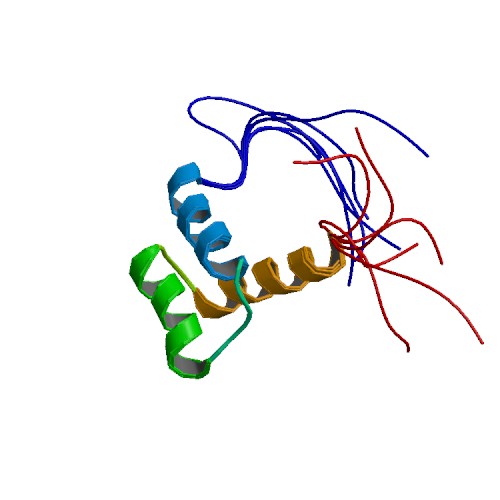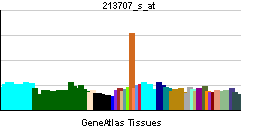DLX5
| Distal-less homeobox 5 | |||||||||||||
|---|---|---|---|---|---|---|---|---|---|---|---|---|---|
 PDB rendering based on 2djn. | |||||||||||||
| |||||||||||||
| Identifiers | |||||||||||||
| Symbols | DLX5 ; | ||||||||||||
| External IDs | Template:OMIM5 Template:MGI HomoloGene: 3825 | ||||||||||||
| |||||||||||||
| RNA expression pattern | |||||||||||||
 | |||||||||||||
| More reference expression data | |||||||||||||
| Orthologs | |||||||||||||
| Template:GNF Ortholog box | |||||||||||||
| Species | Human | Mouse | |||||||||||
| Entrez | n/a | n/a | |||||||||||
| Ensembl | n/a | n/a | |||||||||||
| UniProt | n/a | n/a | |||||||||||
| RefSeq (mRNA) | n/a | n/a | |||||||||||
| RefSeq (protein) | n/a | n/a | |||||||||||
| Location (UCSC) | n/a | n/a | |||||||||||
| PubMed search | n/a | n/a | |||||||||||
Distal-less homeobox 5, also known as DLX5, is a human gene.[1] This gene encodes a member of a homeobox transcription factor gene family similar to the Drosophila distal-less gene. The encoded protein may play a role in bone development and fracture healing. Mutation in this gene, which is located in a tail-to-tail configuration with another member of the family on the long arm of chromosome 7, may be associated with split-hand/split-foot malformation.[1]
References
Further reading
- Bapat S, Galande S (2005). "Association by guilt: identification of DLX5 as a target for MeCP2 provides a molecular link between genomic imprinting and Rett syndrome". Bioessays. 27 (7): 676–80. doi:10.1002/bies.20266. PMID 15954098.
- Simeone A, Acampora D, Pannese M; et al. (1994). "Cloning and characterization of two members of the vertebrate Dlx gene family". Proc. Natl. Acad. Sci. U.S.A. 91 (6): 2250–4. PMID 7907794.
- Scherer SW, Poorkaj P, Massa H; et al. (1995). "Physical mapping of the split hand/split foot locus on chromosome 7 and implication in syndromic ectrodactyly". Hum. Mol. Genet. 3 (8): 1345–54. PMID 7987313.
- Hillier LD, Lennon G, Becker M; et al. (1997). "Generation and analysis of 280,000 human expressed sequence tags". Genome Res. 6 (9): 807–28. PMID 8889549.
- Zhang H, Hu G, Wang H; et al. (1997). "Heterodimerization of Msx and Dlx homeoproteins results in functional antagonism". Mol. Cell. Biol. 17 (5): 2920–32. PMID 9111364.
- Newberry EP, Latifi T, Towler DA (1999). "The RRM domain of MINT, a novel Msx2 binding protein, recognizes and regulates the rat osteocalcin promoter". Biochemistry. 38 (33): 10678–90. doi:10.1021/bi990967j. PMID 10451362.
- Eisenstat DD, Liu JK, Mione M; et al. (1999). "DLX-1, DLX-2, and DLX-5 expression define distinct stages of basal forebrain differentiation". J. Comp. Neurol. 414 (2): 217–37. PMID 10516593.
- Masuda Y, Sasaki A, Shibuya H; et al. (2001). "Dlxin-1, a novel protein that binds Dlx5 and regulates its transcriptional function". J. Biol. Chem. 276 (7): 5331–8. doi:10.1074/jbc.M008590200. PMID 11084035.
- Yu G, Zerucha T, Ekker M, Rubenstein JL (2002). "Evidence that GRIP, a PDZ-domain protein which is expressed in the embryonic forebrain, co-activates transcription with DLX homeodomain proteins". Brain Res. Dev. Brain Res. 130 (2): 217–30. PMID 11675124.
- Sasaki A, Masuda Y, Iwai K; et al. (2002). "A RING finger protein Praja1 regulates Dlx5-dependent transcription through its ubiquitin ligase activity for the Dlx/Msx-interacting MAGE/Necdin family protein, Dlxin-1". J. Biol. Chem. 277 (25): 22541–6. doi:10.1074/jbc.M109728200. PMID 11959851.
- Willis DM, Loewy AP, Charlton-Kachigian N; et al. (2002). "Regulation of osteocalcin gene expression by a novel Ku antigen transcription factor complex". J. Biol. Chem. 277 (40): 37280–91. doi:10.1074/jbc.M206482200. PMID 12145306.
- Strausberg RL, Feingold EA, Grouse LH; et al. (2003). "Generation and initial analysis of more than 15,000 full-length human and mouse cDNA sequences". Proc. Natl. Acad. Sci. U.S.A. 99 (26): 16899–903. doi:10.1073/pnas.242603899. PMID 12477932.
- Scherer SW, Cheung J, MacDonald JR; et al. (2003). "Human chromosome 7: DNA sequence and biology". Science. 300 (5620): 767–72. doi:10.1126/science.1083423. PMID 12690205.
- Okita C, Meguro M, Hoshiya H; et al. (2004). "A new imprinted cluster on the human chromosome 7q21-q31, identified by human-mouse monochromosomal hybrids". Genomics. 81 (6): 556–9. PMID 12782124.
- Hillier LW, Fulton RS, Fulton LA; et al. (2003). "The DNA sequence of human chromosome 7". Nature. 424 (6945): 157–64. doi:10.1038/nature01782. PMID 12853948.
- Ota T, Suzuki Y, Nishikawa T; et al. (2004). "Complete sequencing and characterization of 21,243 full-length human cDNAs". Nat. Genet. 36 (1): 40–5. doi:10.1038/ng1285. PMID 14702039.
- Gerhard DS, Wagner L, Feingold EA; et al. (2004). "The status, quality, and expansion of the NIH full-length cDNA project: the Mammalian Gene Collection (MGC)". Genome Res. 14 (10B): 2121–7. doi:10.1101/gr.2596504. PMID 15489334.
- Rual JF, Venkatesan K, Hao T; et al. (2005). "Towards a proteome-scale map of the human protein-protein interaction network". Nature. 437 (7062): 1173–8. doi:10.1038/nature04209. PMID 16189514.
- Kimura K, Wakamatsu A, Suzuki Y; et al. (2006). "Diversification of transcriptional modulation: large-scale identification and characterization of putative alternative promoters of human genes". Genome Res. 16 (1): 55–65. doi:10.1101/gr.4039406. PMID 16344560.
External links
- DLX5+protein,+human at the US National Library of Medicine Medical Subject Headings (MeSH)
| This protein-related article is a stub. You can help Wikipedia by expanding it. |
This article incorporates text from the United States National Library of Medicine, which is in the public domain.